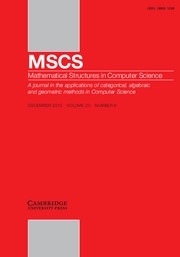Crossref Citations
This article has been cited by the following publications. This list is generated based on data provided by
Crossref.
van Glabbeek, R.J.
2005.
On the Expressiveness of Higher Dimensional Automata.
Electronic Notes in Theoretical Computer Science,
Vol. 128,
Issue. 2,
p.
5.
van Glabbeek, R.J.
2006.
On the expressiveness of higher dimensional automata.
Theoretical Computer Science,
Vol. 356,
Issue. 3,
p.
265.
Cervesato, Iliano
and
Scedrov, Andre
2009.
Relating state-based and process-based concurrency through linear logic (full-version).
Information and Computation,
Vol. 207,
Issue. 10,
p.
1044.
Du, Xutao
Xing, Chunxiao
and
Zhou, Lizhu
2009.
A Chu Spaces Semantics of BPEL-Like Fault Handling.
p.
317.
Du, Xutao
Xing, Chunxiao
and
Zhou, Lizhu
2009.
A Chu spaces semantics of control flow in BPEL.
p.
142.
Pinna, G. Michele
and
Saba, Andrea
2010.
Theory and Applications of Models of Computation.
Vol. 6108,
Issue. ,
p.
385.
Prisacariu, Cristian
2010.
CONCUR 2010 - Concurrency Theory.
Vol. 6269,
Issue. ,
p.
494.
Du, Xu-Tao
Xing, Chun-Xiao
and
Zhou, Li-Zhu
2010.
Modeling and Verifying Concurrent Programs with Finite Chu Spaces.
Journal of Computer Science and Technology,
Vol. 25,
Issue. 6,
p.
1168.
DU, Xutao
XING, Chunxiao
and
ZHOU, Lizhu
2011.
Comparing Process Behaviors with Finite Chu Spaces.
IEICE Transactions on Information and Systems,
Vol. E94-D,
Issue. 6,
p.
1321.
Du, Xutao
Xing, Chunxiao
Zhou, Lizhu
and
Han, Ke
2011.
Modeling Control Flow in WS-BPEL with Chu Spaces.
International Journal of Information Systems in the Service Sector,
Vol. 3,
Issue. 4,
p.
1.
Bochman, Alexander
and
Gabbay, Dov M.
2012.
Causal dynamic inference.
Annals of Mathematics and Artificial Intelligence,
Vol. 66,
Issue. 1-4,
p.
231.
Abramsky, Samson
2012.
Big toy models.
Synthese,
Vol. 186,
Issue. 3,
p.
697.
Du, Xutao
Xing, Chunxiao
Zhou, Lizhu
and
Han, Ke
2013.
Implementation and Integration of Information Systems in the Service Sector.
p.
184.
Abramsky, Samson
2013.
Coalgebras, Chu Spaces, and Representations of Physical Systems.
Journal of Philosophical Logic,
Vol. 42,
Issue. 3,
p.
551.
Johansen, Christian
2016.
ST-structures.
Journal of Logical and Algebraic Methods in Programming,
Vol. 85,
Issue. 6,
p.
1201.
Pratt, Vaughan
2018.
Dynamic Logic. New Trends and Applications.
Vol. 10669,
Issue. ,
p.
153.
Fahrenberg, Uli
Johansen, Christian
Struth, Georg
and
Ziemiański, Krzysztof
2021.
Languages of higher-dimensional automata.
Mathematical Structures in Computer Science,
Vol. 31,
Issue. 5,
p.
575.
Fahrenberg, Uli
Johansen, Christian
Struth, Georg
and
Ziemiański, Krzysztof
2022.
Posets with interfaces as a model for concurrency.
Information and Computation,
Vol. 285,
Issue. ,
p.
104914.
Fahrenberg, Uli
and
Ziemiański, Krzysztof
2023.
Application and Theory of Petri Nets and Concurrency.
Vol. 13929,
Issue. ,
p.
167.


